
The Basics:
- For ages 8 and up
- For 2 to 6 players
- Approximately 15 minutes to complete
Geek Skills:
- Counting & Math
- Logical & Critical Decision Making
- Reading
- Pattern/Color Matching
- Risk vs. Reward
- Hand/Resource Management
Learning Curve:
- Child – Easy
- Adult – Easy
Theme & Narrative:
- Build the ultimate weapon one weird piece at a time
Endorsements:
- Gamer Geek mixed!
- Parent Geek approved!
- Child Geek approved!
Overview
You have toiled for years researching, exploring long forgotten knowledge, and poking around in places no sane person would consider wise. But you are no normal sane person. You have a dream and it will soon become true. Tonight, the ultimate weapon will be built and it’s yours to command. Little do you know that several other “sane” individuals have made the same plans this evening.
One Hit Kill, designed by John August, Ryan Nelson and published by Quote-Unquote, is comprised of 40 Component cards, 20 Weapon cards, and 11 Special cards. The cards are as thick and as durable as your standard playing card. The Weapon cards artwork is outstanding. A number of artists contributed and did a wonderful job of bringing the various monsters, technology, artifacts, and questionably dangerous Weapons to visual life. The game also comes with a double-sided playmat that is somewhat useless. Being folded several times to fit in the game box, it’s difficult to lay flat and is ultimately unnecessary.
Game Set Up
To set up the game, first separate the white cards (that contain Component and Special cards) from the black cards (which are the Weapon cards). Shuffle both piles of cards separately.
Second, deal 7 white cards to each player, face-down. This is the player’s starting hand. Players should feel free to pick it up and look at it, but they should keep it hidden from their opponents.
Third, place the pile of white cards face-down in the middle of the playing area to create the draw deck. Draw the top 3 cards and place them face-up in a row next to the draw deck. This row of 3 cards is referred to as the “Field”. If an “Overload” Special cards is revealed, shuffle it back into the draw deck and draw another card. Cards that are discarded during the game are placed at the end of the Field (or wherever you want to put it).
Fourth, deal 2 black cards to each player, face-down. These are the player’s initial Weapon cards they will be attempting to build. These cards can go into the player’s hand or remain face-down on the table in front of them. Either way, the black cards never count towards a player’s hand size. Place the remaining black cards face-down to create the Weapon draw deck.
That’s it for game set up. Determine who will go first and begin.
Weapon Blueprints
There are a number of fairly outlandish Weapon cards in the game ranging from “What the hell?” to “Hell yeah!” The name and image of the Weapon card has no impact to the game (other than laughter). It’s just there as a thematic element and can be used to create some interesting conversations. What does matter are the icons on the Weapon card. These identify what parts the player needs to collect in order to successfully build that particular weapon.
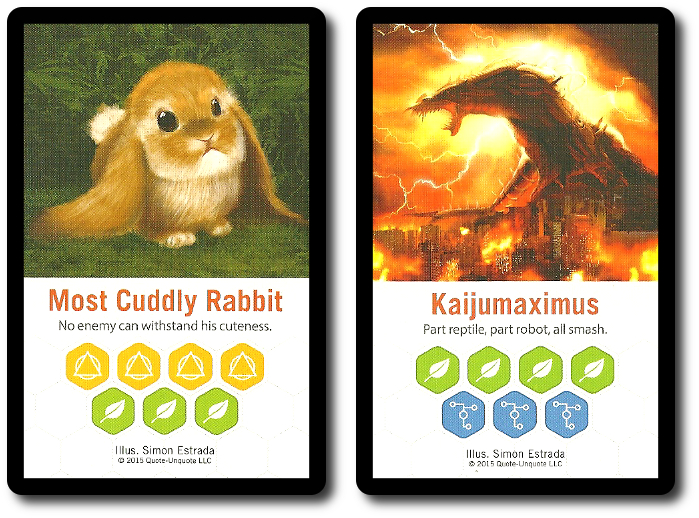
Both of these weapons are exceedingly deadly
In game terms, the icons and colors on a Weapon card are referred to as “Components” and they are found on Component cards. In other words, they represent suits (referred to as “classes” in the game). There are 4 different suits in total, each with a different color. These are Magic (orange eldritch sign), Technology (blue circuit), Elemental (red atom), and Bio (green leaf).

Using these 4 suits, the player will need to collect Component cards that satisfy the requirement building blocks of their Weapon card. This is not as easy as it sounds. In order to successfully build a weapon, the player must have the necessary number of suit cards and each card in the same suit must be in sequential order. In addition, each Component card can only be used once in the building of the Weapon card. Some Weapon cards also require a Component card with a specific number value, but with no restrictions on the color.
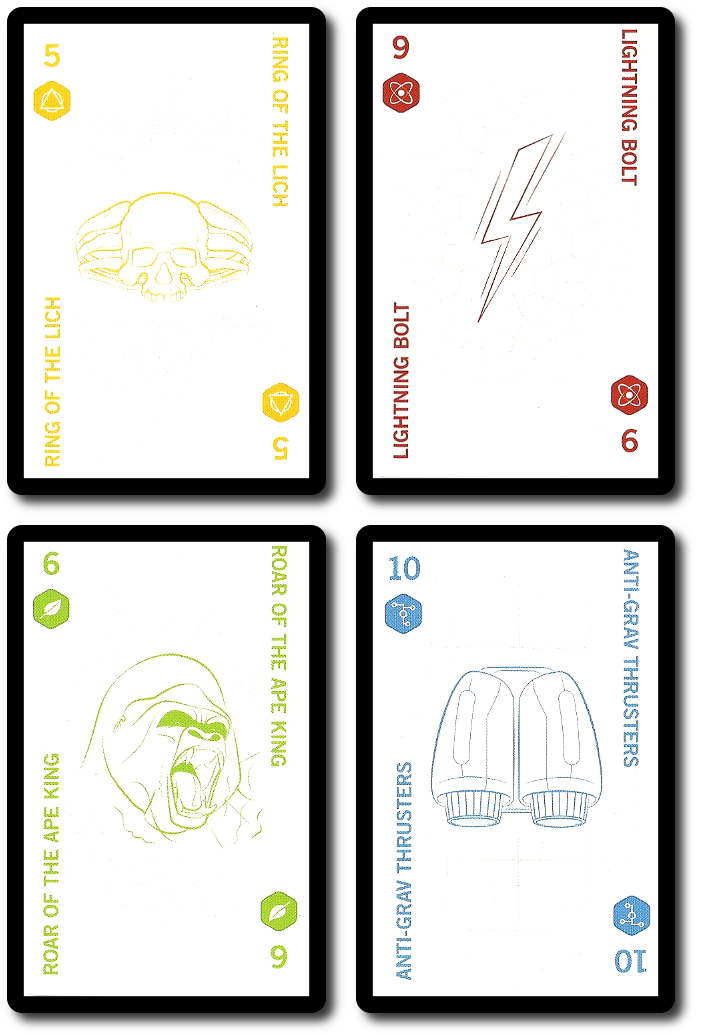
Example of all 4 Component cards
Arms Race
One Hit Kill is played in turns with no set number of turns per game. On a player’s turn they can take 1 action. After completing their single action, the next player in turn order sequence takes their action and so on until the game ends. A summary of each action follows.
Draw One Card
The player can draw the top-most card from the draw deck or select any 1 face-up card in the Field. The selected card is added to the player’s hand. If a card is taken from the Field, a new card is draw to replace it.
Discard Cards
The player can discard any number of cards currently in their hand (not Weapon cards). Discarding should only be considered if the player is holding 11 or more cards in their hand. In either case, it’s an optional action.
Claim a New Weapon
The player draws the top-most card from the Weapon draw deck. This new Weapon card can be built as soon as the player likes and provides another opportunity for the player to win the game. There is no limit to the number of Weapon cards a player can have, but they only need to build 1 to win.
Play a Special Card
The player can place a Special card from their hand to the discard pile. Special cards allow players to draw more cards, search for cards, or force opponents to take actions out of turn. There are two Special cards in particular that deserve a lengthier explanation.
The “Transmute” Special card is played when the a Weapon card is revealed. It acts as a “wild” Component card that can be of any suit, but the number value remains the same.
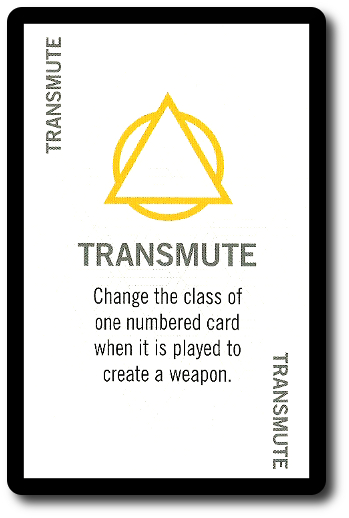
The “Overload” Special card is a pain in the neck. When played, it forces all players (including the player using it) to discard down to 5 white cards if their current hand has 11 or more cards. Thus the reason to seriously consider discarding in the game to avoid losing a lot of cards. In addition, it discards all the cards in the Field, as well.
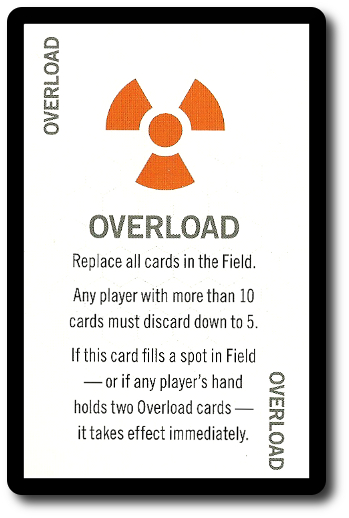
If an “Overload” Special card is ever placed to the Field, it triggers and has the same effect as being played. The game temporary pauses as all players resolve it in accordance to their current hand size. The “Overload” Special card can also automatically trigger if a player has 1 copy of the card in their hand and draws another. BOOM! OVERLOAD!
Reveal Your Weapon!
If the player has the right number, the right colors, and the right sequence of cards that matches what is listed on their Weapon card, they reveal it along with the required Component cards. If the requirements for the Weapon card have not been properly met, the player takes back their cards and ends their turn.
Total Destruction
The game ends as soon as a player reveals their Weapon card and the required Component cards. If everything appears to be correct, they have won the game. Their Weapon is let loose and devastates the world in whatever fashion the player thinks best.
Death & Lore Expansion
Normally, I would dedicate an entire review for a game’s expansion, but in this case, it isn’t necessary. One Hit Kill: Death & Lore expands the core game by introducing 20 Component cards, 15 Weapon cards, and 4 Special cards. The expansion is of the same quality as the core game, slipping into game play seamlessly.
Two new suits are added. These are Death (black with a white skull) and Lore (purple book). These are used just like the core game’s Component cards and are needed by the new Weapon cards in the expansion. Other than their new look and thematic feel, they offer nothing beyond the ordinary.
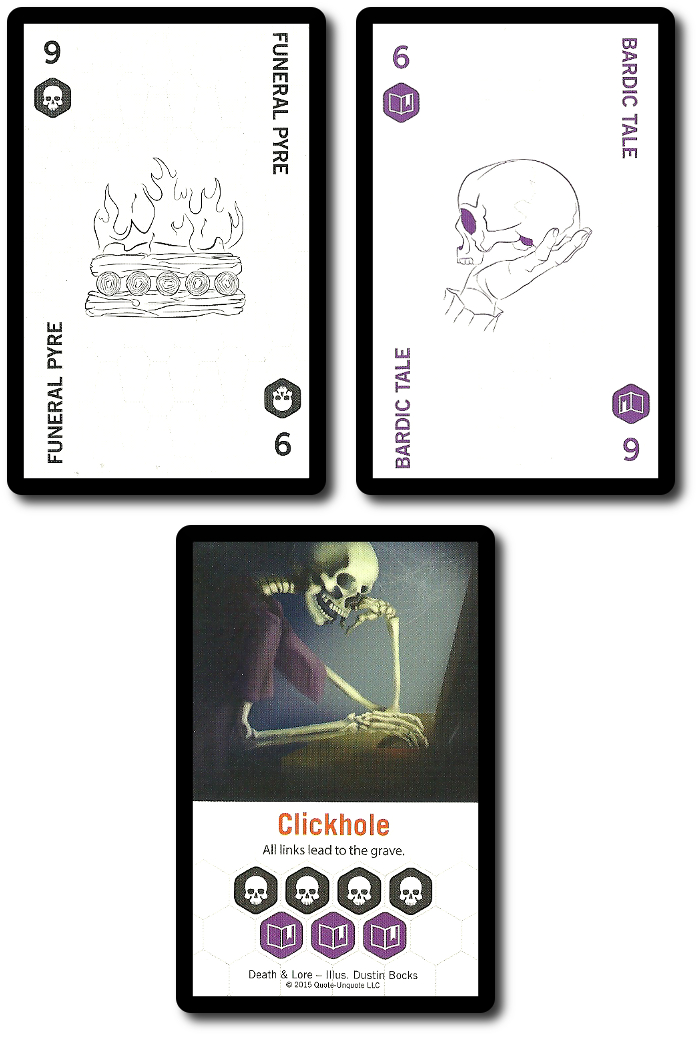
Also known as “Facebook”
Two new Special cards have been added, as well, The first is “Winnow”, which forces players to discard (sort of like a mini “Overload”). The second is “History”, that allows the player to search the discard pile for 1 card and add it to their hand.
The real benefit of the expansion is not what it provides, but who is brings to the table. The core game can only be played with 2 to 3 people. With the expansion, the game can comfortably seat up to 6 players. More players means more action and interaction, making the game something you can share with a lot of friends.
Customizable Creations
One Hit Kill might appear to many as being fairly lean. It’s very clean and minimalistic by design. It was the designers’ intent to create a game that could easily accommodate House Rules and fan made game variants. An example game variant, titled “Communal Weapons”, is provided with the game to demonstrate how easy it is the adjust the game play. Communal Weapons places 2 Weapon cards in the middle of the playing area face-up. All players are working to build 1 of the visible Weapon cards to win. A total of 4 Weapon cards can be in play, giving all the players a shared goal and a frantic race.
To learn more about One Hit Kill, visit the game’s website.
Final Word
The Child Geeks loved the Weapons (many of them made them laugh and scratch their heads in confusion) and easily grasped the requirements to build them. We only had a few issues at first when it came to collecting the right cards. The requirements were more or less self-explanatory for all but the youngest and least experienced Child Geeks. It didn’t take long to get them up to speed, however. According to one Child Geek, “The game can be tricky. You have to collect certain cards, but you want a lot of Weapon cards, too, so you always have options.” Having more Weapon cards certainly does help, but only to a point. Many more times than once, the Child Geeks were hit by the “Overload” card and had to almost start over. As one Child Geek put it, “When the Overload card comes out, you either want to laugh or cry.” Maybe a little of both. When the Weapons were built and there was nothing left of the world, the Child Geeks all voted to approve One Hit Kill.
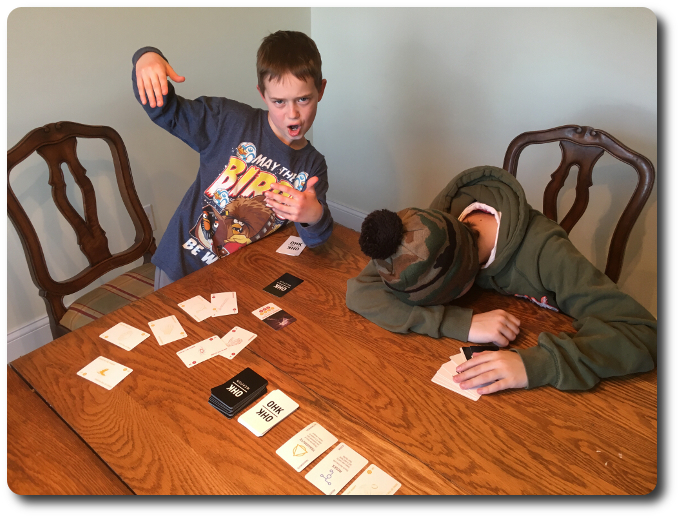
BOOM! Out of nowhere comes the win! I have yet to beat this kid…
The Parent Geeks, the non-gamers specifically, didn’t know what to make of One Hit Kill. Their faces were a mix of interest and doubt as they looked through the Weapon cards. When the game started, they found that One Hit Kill shared many similarities to Gin Rummy, which seemed to please many players. According to one such Parent Geek, “The game has a very comfortable and familiar feel to it. It makes it relaxing to play and a lot of fun to compete.” Another Parent Geek said, “The game is very simple in its approach and the Special cards throw in a few twists, but this game is really all about collecting and pushing your luck as fast as you can. It’s a lot of fun.” Every Parent Geek enjoyed themselves when playing the game with their peers and with their family. They all voted to approve it without hesitation.
If the Parent Geeks were skeptical, the Gamer Geeks were downright leery. To them, One Hit Kill looked to be a waste of their time. As one Gamer Geek put it, “I don’t want to play another one of your stupid time-wasting games, Cyrus.” Regardless, they played (mostly because I made them). After several games, it was time to collect their feedback. To my surprise, the Gamer Geeks had softened their position on the game a great deal. One Gamer Geek said, “It’s not a bad game. Not great, but not bad. I’d play this as a filler.” Another Gamer Geek said, “Certainly better than Fluxx, but not necessarily a lot better. The game is really nothing more than drawing cards over and over again until someone wins, but there is enough to it to make it entertaining.” And one other Gamer Geek said, “I think the game is cute and would do well with families. I’d play the game again, but I’d only play it with non-gamers and relatives.” When the votes were in, the Gamer Geeks game One Hit Kill a mixed level of approval. They all collectively agreed that the game was “OK” to “good”, but not “great”.
One Hit Kill is pretty minimal, and as I’ve already stated, that’s by design. But do not equate minimalism with ease of play. One Hit Kill is not a game you can play with your eyes closed. The game is a race and players must juggle as many cards as they can without putting themselves in prime position to be smacked by the “Overload” Special card. This forces players to continually ask if they need to risk more cards for a faster Weapon build or keep their hand size down so as to avoid the penalty.
The only aspect of the game that I felt was broken was the unlimited Weapon cards. Giving players the ability to collect as many Weapon cards as they like greatly improves their odds of winning. Why allow that to easily happen? The reason, it turned out, was simple. Without the ability to draw an unlimited number of Weapon cards, the game can become very tedious. One Hit Kill is a game that wants a player to win and to win fast. Since Weapon cards do not count as cards in the player’s hand, the game trades unlimited cards with more possible matches. This also reduces the player’s dependency on the luck needed to draw the right cards. Smart.
Speaking of which, there really isn’t any “bad card” in the game. Yes, “Overload” can cause problems, but only for those who forgot it was in the game or risked too much. Either way, the entire situation is fairly moot since games rarely take longer than 10 minutes to complete. This means a player who is suffering the worst luck in the game need not suffer long. A quick game can be had followed by another and then another, satisfying everyone’s need to build big weapons and play fast games.
If you enjoy casual card games, like a little bit of risk with your reward, and can keep a straight face when someone slaps down a cute bunny Weapon card yelling, “FEAR MY WRATH!”, then this is the game for you. One Hit Kill is by no means a killer game, but it will certainly be one game you’ll enjoy playing.
This game was given to Father Geek as a review copy. Father Geek was not paid, bribed, wined, dined, or threatened in vain hopes of influencing this review. Such is the statuesque and legendary integrity of Father Geek.



